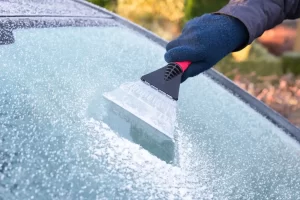Ice buildup can lead to significant damage and costly repairs for homeowners. Understanding its causes is essential for prevention. Implementing effective insulation and proper drainage solutions can make a difference. Regular maintenance also plays a vital role in minimizing risks. However, even with precautions, emergencies may arise. Exploring practical strategies can help mitigate these issues and protect outdoor spaces from winter’s harsh effects.
Key Takeaways
- Regularly clear gutters and downspouts to ensure proper drainage and prevent water accumulation that can freeze.
- Inspect and maintain roofs for damaged shingles to avoid water pooling and ice formation.
- Apply weatherstripping to seal gaps and cracks, minimizing cold air entry and moisture retention.
- Use foam board insulation in outdoor areas to reduce heat loss and ice buildup.
- Trim trees and shrubs to prevent ice-laden branches from causing damage to structures.
Understanding the Causes of Ice Buildup
Understanding the causes of ice buildup is essential for effective prevention. Ice accumulation typically occurs when warm air rises and meets colder surfaces, leading to melting and refreezing. This phenomenon often takes place on roofs and in gutters, where insufficient drainage can trap water. Additionally, poor ventilation can exacerbate these conditions, allowing moisture to linger and freeze. Factors such as fluctuating temperatures, humidity levels, and the orientation of the building also play significant roles in ice formation. Recognizing these underlying causes empowers homeowners to take proactive measures. By understanding how to prevent ice buildup, individuals can foster a sense of belonging within their community, ensuring safer outdoor environments for everyone. Awareness and action can mitigate risks and foster well-maintained spaces.
Effective Insulation Techniques for Outdoor Areas
Effective insulation techniques are essential for maintaining outdoor areas free from ice buildup, especially in regions prone to fluctuating winter temperatures. Proper insulation not only helps in retaining heat but also minimizes the risk of ice formation. Here are four effective insulation methods to take into account:
- Foam Board Insulation: Use rigid foam panels to insulate walls, foundations, and crawl spaces.
- Reflective Barriers: Install reflective insulation in attics to deflect heat and reduce ice melting.
- Insulated Tarps: Cover outdoor equipment and furniture with insulated tarps to protect against cold air.
- Weatherstripping: Seal gaps and cracks in outdoor structures to prevent cold drafts.
Choosing the Right Drainage Solutions
Proper insulation techniques can greatly reduce the chances of ice formation, but they must be complemented by efficient drainage solutions. Effective drainage systems prevent water accumulation that can freeze, leading to potential damage. Homeowners should consider installing gutters and downspouts that direct water away from structures. Additionally, incorporating French drains or trench drains can effectively manage excess water in yard areas. Choosing permeable paving stones encourages proper water absorption, further reducing ice buildup. Regularly inspecting and clearing these systems guarantees they function at their best. By selecting appropriate drainage solutions, individuals can substantially lower the risk of ice-related issues, fostering a safer environment for families and maintaining the integrity of outdoor spaces. Understanding how to prevent ice buildup is essential for long-term property care.
Regular Maintenance Tips to Prevent Ice Accumulation
While ice accumulation can pose significant risks to properties, regular maintenance plays an essential role in prevention. Homeowners can take proactive steps to minimize the likelihood of ice buildup and guarantee their outdoor spaces remain safe and functional. Here are four effective maintenance tips:
- Clear Gutters and Downspouts: Make certain these are free of debris to facilitate proper drainage.
- Inspect Roofs: Regularly check for damaged shingles or areas where water may pool.
- Trim Trees and Shrubs: Remove overhanging branches to prevent ice-laden limbs from causing damage.
- Seal Cracks and Gaps: Use caulk or weather stripping to minimize cold air infiltration and reduce ice formation.
Emergency Measures for Existing Ice Buildup
When ice buildup occurs, immediate action is essential to prevent further damage and secure safety. First, identify the affected areas, such as roofs, walkways, and driveways. Carefully remove loose snow and debris to reduce pressure on the ice. Applying a de-icing agent can help, with options like calcium chloride or salt effectively melting ice. For larger areas, hot water can also be used, but caution is needed to avoid refreezing. If safety is a concern, consider enlisting professional help. Additionally, guarantee proper drainage by clearing gutters and downspouts to prevent future ice buildup. By taking these emergency measures, homeowners can mitigate risks and maintain a safe, welcoming environment during winter months. Understanding how to prevent ice buildup is key to long-term care.
Frequently Asked Questions
What Types of Materials Are Best for Ice Prevention?
When considering materials for ice prevention, options like heated mats, insulated roofing, and proper drainage systems prove effective. These materials work together to minimize ice formation, ensuring safety and reducing potential damage during winter months.
How Does Sunlight Affect Ice Buildup in Outdoor Areas?
Sunlight plays an essential role in ice buildup, as warmer rays can melt existing ice and prevent accumulation. Areas exposed to direct sunlight typically experience less ice formation, promoting safer outdoor conditions and reducing potential hazards.
Can Plants Help Prevent Ice Accumulation?
Plants can help prevent ice accumulation by absorbing moisture and providing shade, which reduces melting and refreezing. Additionally, their root systems improve soil drainage, further minimizing the potential for ice buildup in outdoor areas.
What Role Does Wind Play in Ice Formation?
Wind influences ice formation by affecting temperature and moisture levels. Strong winds can lower surface temperatures, promoting freezing, while also dispersing moisture. Hence, understanding wind patterns is essential for anticipating ice buildup in outdoor environments.
Are There Any Eco-Friendly Solutions for Preventing Ice Buildup?
Eco-friendly solutions for preventing ice buildup include using sand or gravel for traction, applying beet juice or vinegar mixtures as de-icers, and ensuring proper drainage to minimize water pooling, fostering community awareness and environmental responsibility.
Conclusion
By implementing these straightforward strategies, homeowners can greatly reduce the risk of ice buildup and the potential for costly repairs. Understanding the causes of ice accumulation, utilizing effective insulation techniques, and ensuring proper drainage are essential steps. Regular maintenance and timely emergency measures will further enhance protection against winter weather threats. Taking proactive action not only safeguards property but also promotes a safer environment during the colder months.
You May Also Like To Read:


